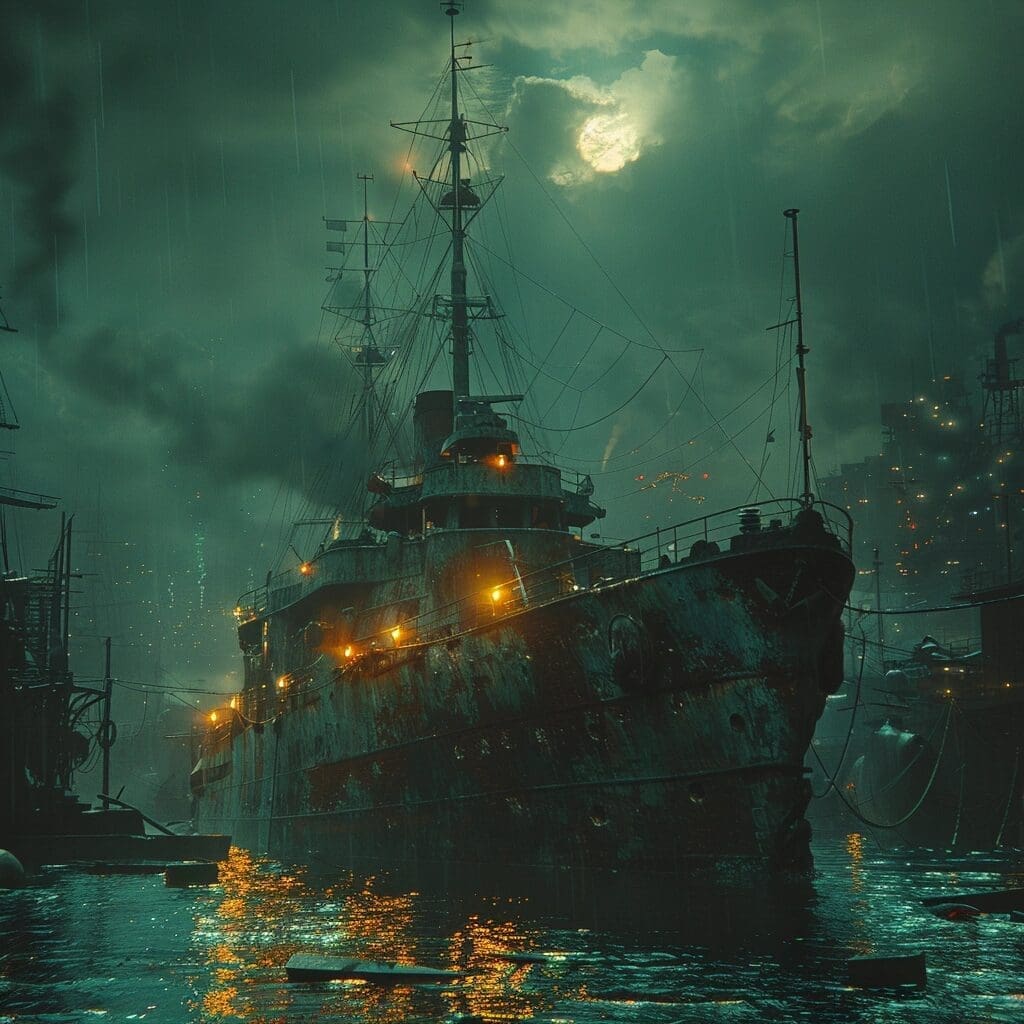
It’s not just the Titanic that succumbed to the iceberg rich waters of the North Atlantic, sinking approximately 360 nautical miles southeast of Whale House Guest House, now laying 2,100 fathoms below the choppy surface.
Southern Newfoundland, with its rugged coastline and tumultuous waters, has been the final resting place for many a vessel and the backdrop for tales of ghost ships that still haunt the maritime lore. The area’s history is rich with stories of bravery, tragedy, and mystery, offering a glimpse into the perilous life at sea.
This blog post will explore some of the most famous shipwrecks and ghost ships in Southern Newfoundland, shedding light on the tales that have captivated the imagination of locals and visitors alike.
The S.S. Florizel: A Tale of Tragedy and Heroism
If you’re staying at Whale House or find yourself exploring close to Cribbies Meadows or Tinker’s Point Path the site of the Florizel is just to the south, near Cappahayden. It’s makes for a great day trip for those looking to get off the beaten path and explore. It’s also easy to include as part of any outing to Mistaken Point.
One of the most heart-wrenching stories is that of the S.S. Florizel, a passenger liner that met its doom in 1918 off the coast of Cape Race, Newfoundland. Setting sail from St. John’s to Halifax, the Florizel hit a violent storm, crashing into the rocks and claiming the lives of 94 of the 138 souls on board.
The story of the Florizel is not just one of tragedy but also of heroism, as rescuers braved the treacherous conditions to save 44 passengers in a daring operation. Today, the wreck is a haunting dive site where divers can explore the remnants of this once-majestic liner and pay homage to those lost at sea.
The Truxtun and Pollux Disaster: A World War II Calamity
During World War II, the U.S. Navy destroyers Truxtun and Pollux found themselves caught in a fierce storm, leading to one of the most devastating shipwrecks in Newfoundland’s history.
In February 1942, both ships ran aground near the small community of St. Lawrence, resulting in the loss of over 200 sailors. The disaster is remembered not only for its scale but for the incredible acts of bravery by the people of St. Lawrence, who risked their lives to rescue survivors from the freezing waters. The wrecks have since become sacred ground, serving as a stark reminder of the perils of war and the sea.
The Ghost Ship of St. Shotts: A Phantom Vessel
No tale of Southern Newfoundland’s maritime history would be complete without mentioning the ghost ship of St. Shotts. Witnesses have reported seeing a phantom vessel appearing out of the mist, sailing just off the coast before vanishing as mysteriously as it appeared.
This ghost ship is said to be a harbinger of storms, with sightings often preceding bad weather. While the true identity of this spectral ship remains a mystery, it continues to be a source of fascination and eerie tales among the locals.
The Wreck of the SS Anglo Saxon in Bay Bulls
The SS Anglo Saxon, a brig sailing under the British flag, met its fate near Bay Bulls in 1863. Carrying a valuable cargo, including silver and lead, it struck a hidden reef and sank. Over the years, the wreck became the stuff of legend, partly due to the valuable cargo it was rumored to carry. Divers and treasure hunters have been drawn to the waters of Bay Bulls in hopes of uncovering riches and artifacts from the Anglo Saxon. The wreck, lying in relatively shallow water, is a tangible connection to the maritime heritage of the area and a reminder of the treacherous navigation conditions that have claimed many ships over the centuries.
Phantom Lights of Mobile Bay
Whale House is located on the shores of Mobile Bay. Even to this day, guests sometimes report seeing strange lights on the sea and along the barren coast. Puffins and seabirds in this area are known for becoming disoriented during full moons and the dark night sky superimposed with stars and strips of constellations makes for a festival of lights of any clear evening.
The communities along this rugged coast are also home to tales of ghostly apparitions and unexplained phenomena. One such story is the phantom lights observed in Mobile Bay, where mysterious lights have been reported moving along the shore or just above the water’s surface.
Local lore suggests these lights could be the lanterns of fishermen lost at sea, still trying to find their way home. While there’s no tangible wreck associated with these lights, the stories contribute to the rich tapestry of maritime folklore that characterizes this region of Newfoundland.
Ferryland’s Pirate History and Shipwrecks
Ferryland, known for its archaeological significance and historical sites, also holds tales of piracy and shipwrecks. The area was frequented by European fishermen and pirates in the 17th and 18th centuries, and it’s believed that several ships met their end along its rocky shores.
While specific wreck tales are less documented, the general history of Ferryland includes encounters with privateers and pirates, adding a layer of intrigue and danger to its maritime legacy.
The Guardian of Tors Cove

In Tors Cove, a story is told of a ghost ship that appears as a harbinger of storms.
Like the ghost ship of St. Shotts, this spectral vessel is said to manifest under dark clouds, warning fishermen and sailors of impending bad weather.
Though no specific shipwreck is tied to the appearance of this ghost ship, it’s an integral part of the local oral tradition, embodying the respect and caution with which the people of Tors Cove regard the sea.
Respecting the Depths: Conservation Efforts
As we delve into these stories of shipwrecks and ghost ships, it’s crucial to remember the importance of respecting these sites. Many wrecks are not only historical landmarks but also gravesites for those who lost their lives.
Conservation efforts in Southern Newfoundland aim to preserve these wrecks for future generations, ensuring that the tales of bravery, tragedy, and mystery remain alive.
The Wreck of the HMS Raleigh: A Naval Misfortune

The HMS Raleigh, a British warship, met a tragic end on the shores of Point Amour in 1922. On a foggy August night, the Raleigh was navigating the treacherous waters near the Labrador coast when it struck a reef and ran aground.
The incident was a significant blow to the Royal Navy, but thankfully, nearly all of the crew were saved, thanks to the efforts of local fishermen and the nearby community.
The wreck of the Raleigh remains a popular site for divers and historians, offering a glimpse into the naval history and the challenges faced by those navigating Newfoundland’s coastline. The story of the Raleigh serves as a reminder of the unpredictable nature of the sea and the importance of local knowledge in rescue operations.
The Mystery of the SS Ethie: Surviving a Storm
In December 1919, the SS Ethie encountered a fierce storm while en route from Port Saunders to St. John’s, carrying passengers and a cargo of mail and livestock. Battling high seas and blizzard conditions, the ship ultimately ran aground near Martin’s Point, close to the community of Sally’s Cove. Remarkably, all aboard were saved, including an infant, who was famously sent to shore in a mailbag over the pounding surf.
The wreckage of the SS Ethie is still visible today, scattered along the rocky coast, and has become a poignant attraction for those interested in the resilience of both the ship’s crew and the local communities who rallied to their aid.
Reflections on These Maritime Tragedies
Adding the stories of the HMS Raleigh and the SS Ethie to our exploration of Southern Newfoundland’s shipwrecks and ghost ships enriches our understanding of the region’s complex relationship with the sea. These tales, marked by tragedy, heroism, and survival, highlight the human capacity to face the formidable forces of nature with courage and solidarity.
The rugged coastline of Southern Newfoundland, with its history of shipwrecks, serves as a powerful reminder of the sea’s unpredictable nature and the bravery of those who sail its waters. These stories of maritime misfortune and miraculous survival continue to captivate the imagination, offering endless fascination for historians, adventurers, and storytellers.
As we honor the memories of those lost at sea and celebrate the survivors’ tales, we also recognize the ongoing efforts to preserve these underwater cultural heritage sites. These shipwrecks not only tell the story of maritime history in Newfoundland but also underscore the importance of respecting and protecting these sacred sites for future generations.
Newfoundland is a Shipwreck Hunter’s Paradise
The shipwrecks and ghost ships of Southern Newfoundland are more than just stories; they are poignant reminders of the sea’s power and the human spirit’s resilience. As we explore these tales, we connect with the past, understanding the sacrifices made and the dangers faced by those who ventured into these treacherous waters.
Southern Newfoundland’s coastline, marked by these tales of shipwrecks and phantom ships, continues to captivate the hearts of those who hear its stories, a testament to the enduring allure of the sea’s mysteries.





One Response
Love shipwrecks